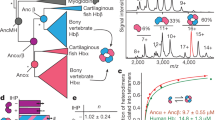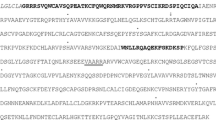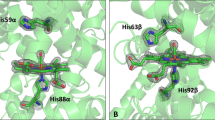Abstract
Truncated hemoglobins (trHbs) are heme proteins found in bacteria, plants, and unicellular eukaryotes. They are distantly related to vertebrate hemoglobins and are typically shorter than these by 20–40 residues. The multiple amino acid deletions, insertions, and replacements result in distinctive alterations of the canonical globin fold and a wide range of chemical properties. An early phylogenetic analysis categorized trHbs into three groups, I (trHbN), II (trHbO), and III (trHbP). Here, we revisit this analysis with 111 trHbs. We find that trHbs are orthologous within each group and paralogous across the groups. Group I globins form the most disparate set and separate into two divergent subgroups. Group II is comparatively homogeneous, whereas Group III displays the highest level of overall conservation. In Group I and Group II globins, for which some ligand binding and structural data are available, an improved description of probable protein-ligand interactions is achieved. Other conservation trends are either confirmed (essential glycines in loops), refined (lining of ligand access tunnel), or newly identified (helix start signal). The Group III globins, so far uncharacterized, exhibit recognizable heme cavity residues while lacking some of the residues thought to be important to the trHb fold. An analysis of the phylogenetic trees of each group provides a plausible scenario for the emergence of trHbs, by which the Group II trHb gene was the original gene, and the Group I trHb and Group III trHb genes were obtained via duplication and transfer events.







Similar content being viewed by others
Notes
By convention, trHbs are aligned with Physeter catodon (sperm whale) myoglobin and discussed using the customary helix numbering (Perutz 1979).
Tyr B10, which is strictly conserved, is engaged in a covalent bond through its Oη atom with Tyr CD1 in a portion of the crystallized molecules, presumably increasing the stability of the bound state (Milani et al. 2003). It is not known whether this posttranslational modification occurs in vivo.
References
Altschul SF, Gish W, Miller W, Myers EW, Lipman DJ (1990) Basic local alignment search tool. J Mol Biol 215:403–410
Aurora R, Rose GD (1998) Helix capping. Protein Sci 7:21–38
Baldwin J, Chothia C (1979) Haemoglobin: the structural changes related to ligand binding and its allosteric mechanism. J Mol Biol 129:175–220
Bashford D, Chothia C, Lesk AM (1987) Determinants of a protein fold. Unique features of the globin amino acid sequences. J Mol Biol 196:199–216
Bolognesi M, Bordo D, Rizzi M, Tarricone C, Ascenzi P (1997) Nonvertebrate hemoglobins: structural bases for reactivity. Prog Biophys Mol Biol 68:29–68
Brown JR (2003) Ancient horizontal gene transfer. Nat Rev Genet 4:121–132
Clamp M, Cuff J, Searle SM, Barton GJ (2004) The Jalview Java alignment editor. Bioinformatics 20:426–427
Couture M, Das TK, Lee HC, Peisach J, Rousseau DL, Wittenberg BA, Wittenberg JB, Guertin M (1999a) Chlamydomonas chloroplast ferrous hemoglobin. Heme pocket structure and reactions with ligands. J Biol Chem 274:6898–6910
Couture M, Yeh SR, Wittenberg BA, Wittenberg JB, Ouellet Y, Rousseau DL, Guertin M (1999b) A cooperative oxygen-binding hemoglobin from Mycobacterium tuberculosis. Proc Natl Acad Sci USA 96:11223–11228
Couture M, Das TK, Savard PY, Ouellet Y, Wittenberg JB, Wittenberg BA, Rousseau DL, Guertin M (2000) Structural investigations of the hemoglobin of the cyanobacterium Synechocystis PCC6803 reveal a unique distal heme pocket. Eur J Biochem 267:4770–4780
Creevey CJ, Fitzpatrick DA, Philip GK, Kinsella RJ, O’Connell MJ, Pentony MM, Travers SA, Wilkinson M, McInerney JO (2004) Does a tree-like phylogeny only exist at the tips in the prokaryotes? Proc R Soc Lond B Biol Sci 271:2551–2558
Das TK, Weber RE, Dewilde S, Wittenberg JB, Wittenberg BA, Yamauchi K, Van Hauwaert ML, Moens L, Rousseau DL (2000) Ligand binding in the ferric and ferrous states of Paramecium hemoglobin. Biochemistry 39:14330–14340
Das TK, Couture M, Ouellet Y, Guertin M, Rousseau DL (2001) Simultaneous observation of the O—O and Fe—O2 stretching modes in oxyhemoglobins. Proc Natl Acad Sci USA 98:479–484
Egawa T, Yeh SR (2005) Structural and functional properties of hemoglobins from unicellular organisms as revealed by resonance Raman spectroscopy. J Inorg Biochem 99:72–96
Falzone CJ, Christie Vu B, Scott NL, Lecomte JTJ (2002) The solution structure of the recombinant hemoglobin from the cyanobacterium Synechocystis sp. PCC 6803 in its hemichrome state. J Mol Biol 324:1015–1029
Freitas TA, Saito JA, Hou S, Alam M (2005) Globin-coupled sensors, protoglobins, and the last universal common ancestor. J Inorg Biochem 99:23–33
Frey AD, Kallio PT (2003) Bacterial hemoglobins and flavohemoglobins: versatile proteins and their impact on microbiology and biotechnology. FEMS Microbiol Rev 27:525–545
Giangiacomo L, Ilari A, Boffi A, Morea V, Chiancone E (2005) The truncated oxygen-avid hemoglobin from Bacillus subtilis. X-ray structure and ligand binding properties. J Biol Chem 280:9192–9202
Hardison RC (1996) A brief history of hemoglobins: plant, animal, protist, and bacteria. Proc Natl Acad Sci USA 93:5675–5679
Hedges SB (2002) The origin and evolution of model organisms. Nat Rev Genet 3:838–849
Hill DR, Belbin TJ, Thorsteinsson MV, Bassam D, Brass S, Ernst A, Boger P, Paerl H, Mulligan ME, Potts M (1996) GlbN (cyanoglobin) is a peripheral membrane protein that is restricted to certain Nostoc spp. J Bacteriol 178:6587–6598
Hiner AN, Raven EL, Thorneley RN, Garcia-Canovas F, Rodriguez-Lopez JN (2002) Mechanisms of compound I formation in heme peroxidases. J Inorg Biochem 91:27–34
Hoy JA, Kundu S, Trent JT 3rd, Ramaswamy S, Hargrove MS (2004) The crystal structure of Synechocystis hemoglobin with a covalent heme linkage. J Biol Chem 279:16535–16542
Karpen ME, de Haseth PL, Neet KE (1992) Differences in the amino acid distributions of 310-helices and a-helices. Protein Sci 1:1333–1342
Kendrew JC, Bodo G, Dintzis HM, Parrish RG, Wyckoff H, Phillips DC (1958) A three-dimensional model of the myoglobin molecule obtained by x-ray analysis. Nature 181:662–666
Kumar S, Tamura K, Jakobsen IB, Nei M (2001) MEGA2: Molecular Evolutionary Genetics Analysis software. Bioinformatics 17:1244–1245
Kundu S, Trent JT 3rd, Hargrove MS (2003) Plants, humans and hemoglobins. Trends Plant Sci 8:387–393
Lecomte JTJ, Scott NL, Vu BC, Falzone CJ (2001) Binding of ferric heme by the recombinant globin from the cyanobacterium Synechocystis sp. PCC 6803. Biochemistry 40:6541–6552
Lecomte JTJ, Vuletich DA, Lesk AM (2005) Structural divergence and distant relationships in proteins: evolution of the globins. Curr Opin Struct Biol 15:290–301
Lesk AM, Chothia C (1980) How different amino acid sequences determine similar protein structures: the structure and evolutionary dynamics of the globins. J Mol Biol 136:225–270
Milani M, Pesce A, Ouellet Y, Ascenzi P, Guertin M, Bolognesi M (2001) Mycobacterium tuberculosis hemoglobin N displays a protein tunnel suited for O2 diffusion to the heme. EMBO J 20:3902–3909
Milani M, Savard PY, Ouellet H, Ascenzi P, Guertin M, Bolognesi M (2003) A TyrCD1/TrpG8 hydrogen bond network and a TyrB10TyrCD1 covalent link shape the heme distal site of Mycobacterium tuberculosis hemoglobin O. Proc Natl Acad Sci USA 100:5766–5771
Milani M, Ouellet Y, Ouellet H, Guertin M, Boffi A, Antonini G, Bocedi A, Mattu M, Bolognesi M, Ascenzi P (2004a) Cyanide binding to truncated hemoglobins: a crystallographic and kinetic study. Biochemistry 43:5213–5221
Milani M, Pesce A, Ouellet Y, Dewilde S, Friedman JM, Ascenzi P, Guertin M, Bolognesi M (2004b) Heme-ligand tunneling in group I truncated hemoglobins. J Biol Chem 279:21520–21525
Milani M, Pesce A, Nardini M, Ouellet H, Ouellet Y, Dewilde S, Bocedi A, Ascenzi P, Guertin M, Moens L, Friedman JM, Wittenberg JB, Bolognesi M (2005) Structural bases for heme binding and diatomic ligand recognition in truncated hemoglobins. J Inorg Biochem 99:97–109
Moens L, Vanfleteren J, Van de Peer Y, Peeters K, Kapp O, Czeluzniak J, Goodman M, Blaxter M, Vinogradov S (1996) Globins in nonvertebrate species: dispersal by horizontal gene transfer and evolution of the structure-function relationships. Mol Biol Evol 13:324–333
Monod J, Wyman J, Changeux JP (1965) On the nature of allosteric transitions: A plausible model. J Mol Biol 12:88–118
Nisbet RE, Kilian O, McFadden GI (2004) Diatom genomics: genetic acquisitions and mergers. Curr Biol 14:R1048–R1050
Ouellet H, Ouellet Y, Richard C, Labarre M, Wittenberg B, Wittenberg J, Guertin M (2002) Truncated hemoglobin HbN protects Mycobacterium bovis from nitric oxide. Proc Natl Acad Sci USA 99:5902–5907
Ouellet H, Juszczak L, Dantsker D, Samuni U, Ouellet YH, Savard PY, Wittenberg JB, Wittenberg BA, Friedman JM, Guertin M (2003) Reactions of Mycobacterium tuberculosis truncated hemoglobin O with ligands reveal a novel ligand-inclusive hydrogen bond network. Biochemistry 42:5764–5774
Perutz MF (1979) Regulation of oxygen affinity of hemoglobin: influence of structure of the globin on the heme iron. Annu Rev Biochem 48:327–386
Perutz MF (1990) Mechanisms of cooperativity and allosteric regulation in proteins. Cambridge University Press, Cambridge
Pesce A, Couture M, Dewilde S, Guertin M, Yamauchi K, Ascenzi P, Moens L, Bolognesi M (2000) A novel two-over-two a-helical sandwich fold is characteristic of the truncated hemoglobin family. EMBO J 19:2424–2434
Phillips SEV, Schoenborn BP (1981) Neutron diffraction reveals oxygen-histidine hydrogen bond in oxymyoglobin. Nature 292:81–82
Porter RD (1986) Transformation in cyanobacteria. Crit Rev Microbiol 13:111–132
Presta LG, Rose GD (1988) Helix signals in proteins. Science 240:1632–1641
Ptitsyn OB, Ting KL (1999) Non–functional conserved residues in globins and their possible role as a folding nucleus. J Mol Biol 291:671–682
Scala S, Carels N, Falciatore A, Chiusano ML, Bowler C (2002) Genome properties of the diatom Phaeodactylum tricornutum. Plant Physiol 129:993–1002
Schloss PD, Handelsman J (2004) Status of the microbial census. Microbiol Mol Biol Rev 68:686–691
Scott NL, Falzone CJ, Vuletich DA, Zhao J, Bryant DA, Lecomte JTJ (2002) Truncated hemoglobin from the cyanobacterium Synechococcus sp. PCC 7002: evidence for hexacoordination and covalent adduct formation in the ferric recombinant protein. Biochemistry 41:6902–6910
Tatusov RL, Koonin EV, Lipman DJ (1997) A genomic perspective on protein families. Science 278:631–637
Thompson JD, Gibson TJ, Plewniak F, Jeanmougin F, Higgins DG (1997) The CLUSTAL_X windows interface: flexible strategies for multiple sequence alignment aided by quality analysis tools. Nucleic Acids Res 25:4876–4882
Thorsteinsson MV, Bevan DR, Ebel RE, Weber RE, Potts M (1996) Spectroscopical and functional characterization of the hemoglobin of Nostoc commune UTEX 584 (Cyanobacteria). Biochim Biophys Acta 1292:133–139
Trent JT 3rd, Kundu S, Hoy JA, Hargrove MS (2004) Crystallographic analysis of synechocystis cyanoglobin reveals the structural changes accompanying ligand binding in a hexacoordinate hemoglobin. J Mol Biol 341:1097–1108
Vinogradov SN, (1985) The structure of invertebrate extracellular hemoglobins (erythrocruorins and chlorocruorins). Comp Biochem Physiol B 82:1–15
Vinogradov SN, Walz DA, Pohajdak B, Moens L, Kapp OH, Suzuki T, Trotman CN (1993) Adventitious variability? The amino acid sequences of nonvertebrate globins. Comp Biochem Physiol B 106:1–26
Visca P, Fabozzi G, Petrucca A, Ciaccio C, Coletta M, De Sanctis G, Bolognesi M, Milani M, Ascenzi P (2002) The truncated hemoglobin from Mycobacterium leprae. Biochem Biophys Res Commun 294:1064–1070
Vu BC, Jones AD, Lecomte JTJ (2002) Novel histidine-heme covalent linkage in a hemoglobin. J Am Chem Soc 124:8544–8545
Vu BC, Nothnagel HJ, Vuletich DA, Falzone CJ, Lecomte JTJ (2004a) Cyanide binding to hexacoordinate cyanobacterial hemoglobins: hydrogen-bonding network and heme pocket rearrangement in ferric H117A Synechocystis hemoglobin. Biochemistry 43:12622–12633
Vu BC, Vuletich DA, Kuriakose SA, Falzone CJ, Lecomte JTJ (2004b) Characterization of the heme-histidine cross-link in cyanobacterial hemoglobins from Synechocystis sp. PCC 6803 and Synechococcus sp. PCC 7002. J Biol Inorg Chem 9:183–194
Weber RE, Vinogradov SN (2001) Nonvertebrate hemoglobins: functions and molecular adaptations. Physiol Rev 81:569–628
Wittenberg JB, Bolognesi M, Wittenberg BA, Guertin M (2002) Truncated hemoglobins: a new family of hemoglobins widely distributed in bacteria, unicellular eukaryotes, and plants. J Biol Chem 277:871–874
Wu G, Wainwright LM, Poole RK (2003) Microbial globins. Adv Microb Physiol 47:255–310
Yeh SR (2004) A novel intersubunit communication mechanism in a truncated hemoglobin from Mycobacterium tuberculosis. J Phys Chem B 108:1478–1484
Yeh SR, Couture M, Ouellet Y, Guertin M, Rousseau DL (2000) A cooperative oxygen binding hemoglobin from Mycobacterium tuberculosis. Stabilization of heme ligands by a distal tyrosine residue. J Biol Chem 275:1679–1684
Acknowledgments
This work was supported by NSF Grant MCB-0349409 and NASA Grant NNG04GN33H (D.A.V.). We thank Dr. Arthur Lesk and Nancy Scott for useful discussions and Drs. Don Bryant and Michel Guertin for their careful reading of the manuscript and many suggestions.
Author information
Authors and Affiliations
Corresponding author
Additional information
[Reviewing Editor: Dr. David S. Guttman]
Electronic Supplementary Material
Rights and permissions
About this article
Cite this article
Vuletich, D.A., Lecomte, J.T. A Phylogenetic and Structural Analysis of Truncated Hemoglobins. J Mol Evol 62, 196–210 (2006). https://doi.org/10.1007/s00239-005-0077-4
Received:
Accepted:
Published:
Issue Date:
DOI: https://doi.org/10.1007/s00239-005-0077-4




